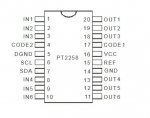I stumbled on this IC today, PT2258, here is the datasheet . Curious if anyone has used it. Looks to be easily controllable with the picaxe. I ordered a few chips to try.
I doubt it's high fidelity but am hoping to be surprised. If it works well it will be perfect for my application, I'm working on an active crossover for my speakers. The active filter is built but it would be nice to control the volume to each driver from listening position. I have abandoned the purist approach to audio, every recording is different and I find i need to dial in the crossover to taste.
I doubt it's high fidelity but am hoping to be surprised. If it works well it will be perfect for my application, I'm working on an active crossover for my speakers. The active filter is built but it would be nice to control the volume to each driver from listening position. I have abandoned the purist approach to audio, every recording is different and I find i need to dial in the crossover to taste.

